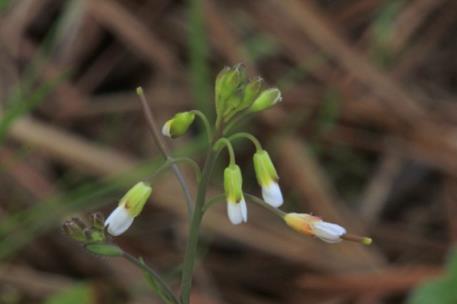
photo by Alan Cressler
"So come up to the lab, and see what's on the slab."
--Dr. Frank N Furter, "Rocky Horror Picture Show"
It is an inconspicuous plant with a great big scientific name. This is one that has found its way out of Europe and Asia, far into the New World and Australia, as a common weed, and now thrives on roadsides, open paths and in vacant lots. In the United States. It is known from basically every state east of the Mississippi River, as well as much of the Pacific coast. Not only that, it has found its way, with the help of modern plant biologists, deep into scientific labs all around the world. In fact, although it is common out of doors, you might be more likely to see it in a scientific setting indoors, as it is a very unassuming little thing, not at all conspicuous.
This is a plant in the mustard family, and is therefore related to cabbage, horse-radish, Brussels-sprouts, wasabi and turnip, among others. It is an annual, and it has an extremely quick life cycle; able to sprout from seeds and grow, soon blooming and setting its own seeds (lots of them), then drying up and disappearing. Its tiny leaves are mostly basal, and the slender stems may reach up to a foot tall on large plants, although are usually shorter than that. Depending on where they grow and how crowded they are, you might find blooming plants that are only three to four inches tall...or up to two feet tall and widely branched. It’s blooming now.
The flowers are typical of the mustard family, with four teeny white petals. The petals (which don’t open up too much) form something of a cross…and this too is characteristic of the mustards, and gives us the old-timey name for the family, which is "Cruciferae," meaning cross-bearing. (Modern-day botanists are more inclined to call this family the “Brassicaceae”, and you can see both of these family names used in various reference books.)
The short life cycle is one thing that has made this plant very interesting to botanists. It is very easy to grow in the lab, and actually represents a model organism for scientific research. Each of its cells contains ten chromosomes, a relatively low number for most plants, and these are easy to study. Beyond that, the thousands of genes packed onto the chromosomes are themselves easy to study and manipulate. Our little friend has become an indispensable part of thousands of sophisticated genetic and molecular studies on plants. Quite a number of researchers are actively studying this plant to figure out the developmental patterns of growth of the flower parts: this growth is under strong influence of a number of genes which are now easily manipulated, to the point that mutant plants with much larger petals, for instance, can be produced. These studies, beyond providing knowledge on the complicated interactions of genetic and environmental expression, may hold keys, in the future, to the development of larger crop plants, potentially capable of producing larger fruits and vegetables. You wouldn't think that such a humble little weed could be so important.
[Answer: "Mouse-ear cress," Arabidopsis thaliana]
---
John Nelson is the retired curator of the A. C. Moore Herbarium at the University of South Carolina in Columbia, SC. As a public service, the Herbarium offers free plant identifications. For more information, visit www.herbarium.org or emailjohnbnelson@sc.rr.com.